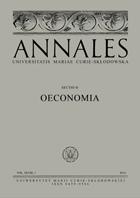Institutional Framework as a Determinant of Variations in Service Quality Between Public and Private Hospitals in Tanzania
Institutional Framework as a Determinant of Variations in Service Quality Between Public and Private Hospitals in Tanzania
Author(s): EMMANUEL MATIKUSubject(s): Welfare systems, Health and medicine and law, Welfare services
Published by: Wydawnictwo Naukowe Uniwersytetu Marii Curie-Sklodowskiej
Keywords: institutional framework; service quality; quality variations; determinants of quality variations;
Summary/Abstract: Purpose of the article: This study was set to determine the influence of institutional framework on service quality in both private and public hospitals. The paper sought to establish the perception of respondents regarding the institutional factors that explain the existence of variations in service quality between public and private hospitals. The institutional framework aspects that were considered in comparing health service quality in public and private hospitals were: institutional culture, control, stability and structure. A descrip- tive survey design was used because the study sought to know the perception of respondents regarding the factors that influence quality of service in hospitals. Research methods: A multistage sampling method was used to select three public hospitals and three private hospitals from the health service sector. The three public hospitals were Muhimbili referral hospital in Dar es Salaam City, Dodoma regional referral hospital and Geita referral hospital in Geita municipality. Private hospitals included in the study were Bugando referral hospital in Mwanza City, St Francis referral hospital in Ifakara town in Morogoro region and Nkinga referral hospital in Tabora region. Medical doctors, nurses and patients were selected using a systematic random sampling method and patients were selected using a convenience sampling method. The total population for the study comprised 10,650 people (i.e. 2,610 doctors and nurses and 8,040 patients) and the selected sample size, which was determined using McCall’s Table was 400 people. Both primary and secondary data collection sources were used. Analysis of the quantitative data was done using the Statistical Package for Social Sciences (SPSS) and qualitative data were transcribed verbatim, coded and analysed manually. All ethical considerations were observed. Main findings: The findings revealed that private hospitals were better in cleanliness compared to public hospitals and physical arrangement was user friendly in private hospitals compared to public hospitals. There was also more control in private hospitals compared to public hospitals in management of resources and this demonstrates an application of strong institutional framework in private hospitals compared to public hospitals in terms of control, structure and culture. Likewise, there was a more friendly atmosphere in private hospitals compared to public hospitals. However, there was more stability in public hospitals compared to private hospitals in terms of financial stability, affordability of service and medical supplies. It is concluded that quality of service provided in private hospitals is higher compared to quality of service in public hospitals. The possible explanation for the causes for differences in levels of service quality could be the existence of strong institutional framework in private hospitals. It is recommended that for higher service quality, organizations should practice the institutional framework aspects in terms of culture, control, stability and structure.
Journal: Annales Universitatis Mariae Curie-Skłodowska, Sectio H Oeconomia
- Issue Year: LVII/2023
- Issue No: 3
- Page Range: 99-122
- Page Count: 24
- Language: English

